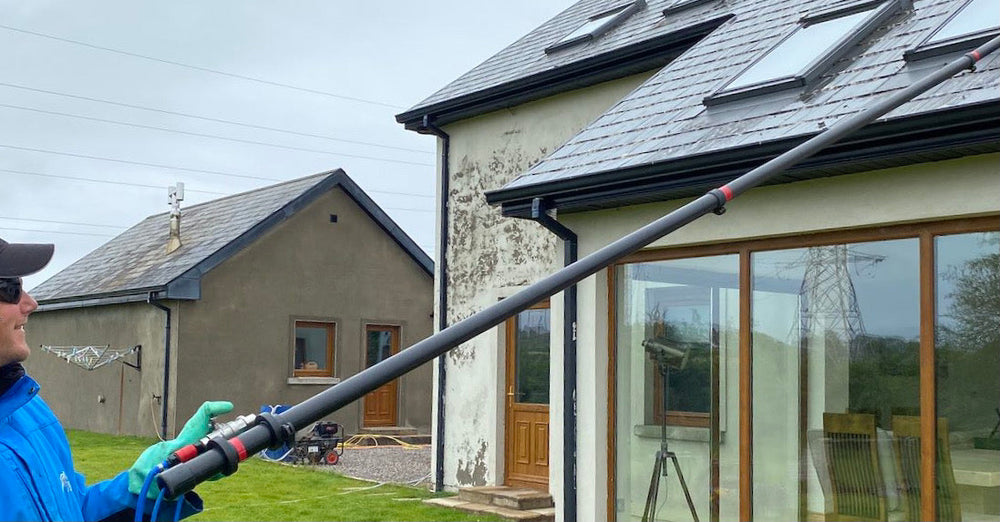
We need to be cautious when soft washing man-made artificial roofing slates.
Man-made artificial roof slates often lose their coating over time, just through natural weathering. And some man-made artificial slates can look white or "patchy" after a softwash treatment.
It's important to let your customer know about this possibility in advance of cleaning their roof.
Cleaning the biofilm from roof slates may expose the fibre cement or other material the slate is made from, which, before soft washing, will have been covered by organic growths.
Although the roofing slate may be structurally sound, the coating may not be. This usually only becomes evident after the man-made artificial slates have been given a softwash treatment.
Quick tip: Let your customer know about this possibility before you begin soft washing a roof.
Quick tip: Let your customer know about this possibility before you begin soft washing a roof.
We tell our customers that their roof will be clean after soft washing but could look patchy because the original coating has worn off. We always take close-up photos before soft washing a roof to prove this.
We've found that the majority of customers believe that a clean but patchy roof is far better looking than a moss covered roof. And we let them know that, if left untreated, the moss will eventually:
- start lifting the slates
- fill the gutters with moss
- attract birds who pick on the moss
- fall on to their clean footpaths, patios, drives below, leading to colonisation and staining
The test patch in the photos below shows what can happen to old slates


The photos below show man made slates that are only seven years old, proving that the coating on relatively new coated slates can also fail quickly.
The roof was eventually re-painted by the manufacturer of the slates, as they carried a ten-year colour guarantee. The roof has not been soft washed or pressure washed.
The roof was eventually re-painted by the manufacturer of the slates, as they carried a ten-year colour guarantee. The roof has not been soft washed or pressure washed.



Organic growths can also damage a roof coating. The 17-second video below shows how the growths can bind with the coating and damage it.
Can damage to fibre-cement roof slates be repaired?
The damage will usually only be to the surface coating, which can be repainted. Fortunately, most of the time the slates themselves will remain sound, so do not need repairing.
We recommend treating man-made roof slates with Benz Bio Cleanze, after manually, and carefully, removing the worst of the moss and lichen.
Bio Cleanze will flow up inside the laps better than other cleaning products, ensuring all the growths and spores are killed. In our experience this is the best way to give a soft wash treatment to clean man-made fibre-cement roof slates.
Bio Cleanze will flow up inside the laps better than other cleaning products, ensuring all the growths and spores are killed. In our experience this is the best way to give a soft wash treatment to clean man-made fibre-cement roof slates.
Important: Always treat an out of the way test patch first and look for the tell-tale pitting of the tile coating before treating or cleaning the whole roof. Always obtain your customer's agreement that the results are acceptable and get their permission to treat the remaining roof surface.
And always take "before" photos so you can prove that any existing damage that soft washing exposes was not caused by soft washing.
Click the links below to learn more about soft washing man-made artificial roof slates:
We hope this information is helpful and sincerely wish you great success in your soft washing business,



Responses
Leo
Hi Doug. Bio Cleanze will have done it’s work after 30-120 minutes but it’s better if it can be allowed to dry into the joints and under the laps. And of course it depends on how long after the treatment it rains and how heavy the rain is. Ideally Bio Cleanze should be left to dry, so check the weather forecast and keep an eye on the sky. In our climate it’s not always possible to allow enough time for complete drying; so allow as long as possible for the biocide to activate, and reschedule if the forecast for your intended working day is for heavy rain.
Copy and paste this link into your browser for more detailed info (or type “rain” into our in-site search engine – the magnifying glass icon in the main menu):
www.benzsoftwash.com/blogs/trade-tips/rain-after-softwashing-applying-bio-cleanze?
May 24, 2022
Doug Eadie
Hi,will rain have any impact on result once roof is spayed?
May 24, 2022
Leo
Hi Sidney
My same comments as for your previous question apply because there are so many permutations of material involved in manufacturing man-made slates.
You could also consider treating with Benz Biocidal Wash, which should do the job without harming anything. The downside is that it can take several months to show full results and you’ll need to educate your customer to be patient while waiting to see the full effects of your work.
The rule is to treat a small test area of any surface you are not sure of before beginning full treatment. That’s the only way to know for sure if a soft wash chemical is going to be safe for a given surface.
Regarding sealing: If you rinse the roof thoroughly after treating with either Benz Blackwash or Benz Biocidal Wash there should not be a problem. To be absolutely certain you should check with the manufacturer of the sealer you want to use if there could be any possible negative implications. Send them our SDS sheets and let them know the surface will be rinsed prior to applying the sealer.
July 31, 2017
sidney murtagh
hi leo i want to spray blackwash on to a chimney to removed red algae will the run off take the coating of man made slats
July 27, 2017
Leo
Hi Sidney,
Thanks for your question. We cannot comment on all man-made slats as the materials can differ from roof to roof. The rule of thumb is always clean a small, obscure test patch first and look for the tell-tale pitting of the tile coating before treating or cleaning the whole roof. Always obtain your customer’s agreement that the results of the test patch are acceptable and get their permission to continue treatment of the remaining roof surface.
Regards sealers, we are testing a sealer now and, if all goes well, will be offering this asap. In the meantime, if you think a surface needs sealing be sure to use a breathable sealer, preferably water-based. Our observations and experience suggests that non-breathable sealers or those that put a thick coating on a surface should be avoided. The sealers we prefer soak into the surface, preventing the ingress of water, without changing the appearance of the surface.
I hope this helps, Leo
May 11, 2017
sidney murtagh
hi ben will all man made slats go white if treated with biocides just clean down a roof now im wondered what to do next need to seal roof after cleaning. thank. sid murtagh
May 04, 2017
Leave a comment